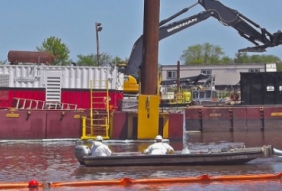
Posted on June 14, 2016
By Rick Olivo, Ashland Daily Press
The Superfund Phase II pilot project, aimed at demonstrating the practicality of using a wet-dredge method of removing contaminants from the nearshore lake bottom near the site of an old manufactured gas plant is on time and working well, says Xcel Energy’s Construction Manager Thomas E. Perry.
The Superfund project is intended to clean up oily, tar-like contaminants that came from the operation of a plant that processed coal to produce a natural gas-like product from 1885 to 1947. Waste from the process wound up contaminating land near the plant and the lake bottom adjacent to the plant.
Excavation of the contaminated sediments from the lake bottom is part of the Superfund cleanup process that has been in the works since the Environmental Protection Agency listed the location as a Superfund site in 2002.
The EPA and the Wisconsin DNR originally favored a dry dredge method which would have involved building an extensive cofferdam system and dredging the material on dry land, but Xcel favored a wet dredge system, which they said was proven technology, safer and less expensive than the dry dredge process.
The current excavation at the site is part of a pilot project, designed to show that wet dredging can be done without causing more environmental damage through resuspension of contaminated material in the water column.
“The project is going very well, Perry said Thursday. “The line contractor is pretty much on schedule, the way we had planned and things are going well. We’ve had nothing unexpected.”
Perry said the pilot project should be completed by the end of June, unless it is determined that additional materials need to be removed. He said if additional work were needed, the materials would be removed hydraulically using what amounts to an underwater vacuum cleaner that will suck up the remaining contaminants. He said that process would take about two more weeks, and would begin sometime after the Fourth of July.
On Thursday, a large excavator on a barge was working near the shore, lifting material from the lake bottom. Using a specially designed scoop that completely encloses the material in the bucket, virtually all the material was deposited into the awaiting container on another barge.
Meanwhile white overall-clad crews on outboard motor-powered workboats pulled booms of oil absorbent material around the barges.
“Any time the marine contractors are working out there, they have a couple of boats dragging booms of absorbent material. It helps keep that oil off the equipment and it helps to minimize the odor.”
Perry said the main problem thus far has been a detectable odor.
“We’ve had some challenges with the odor containment; we are doing what we can, we are suppressing it. There is always going to be some odor; we are just trying to manage it so that it’s not noxious,” he said. “We have had some community complaints, but people have been very polite and tolerant. We are really glad that the community understands that there is going to be some odor with the project, and we have to do the best we can to minimize it.”
Perry said once excavated, the material is hauled to the large tent-like structure at the site where it is treated with a pelletized lime material to help dry it out. The wastewater is treated to remove contaminants and returned to the bay, while the solid material is trucked to a special landfill near Duluth that is licensed to handle it.
One of the most noticeable features of the pilot project is the multiple booms: three immediately around the pilot project area, and one more at the boundary of the overall project. All are equipped with oil-absorbent material, and all function to keep potentially contaminated material in the project water column from escaping out into the bay.
“The three layers of containment booms have worked very well; we’ve had no material escaping,” Perry said.”
Just outside the triple boom systems are a series of solar cell-powered monitoring buoys, which measure both water turbidity and water chemistry.
Those monitors have detected no release of contamination, Perry said.
“The barriers are performing as designed. We had some pretty strong winds last weekend, and some of the guys who witnessed it said the barriers were rising and falling a lot, but they continued to do their job,” he said.
Greatly assisting the barriers was the presence of the new 840-foot-long breakwater, Perry said.
“If you looked at the whitecaps that were in the water outside of the breakwater, versus what was inside, yes, it is a big help,” he said.
Perry said the performance of the pilot project to date was a testimony to the efforts of the crews involved.
“We are doing some pretty sophisticated monitoring of the water, for chemistry as well as turbidity and we also have a crew of technicians working in air monitoring. They are making sure that nothing is leaving the jobsite that could be a health risk,” he said. “We are doing well, and on schedule, and that is a good thing.”
Source: Ashland Daily Press





